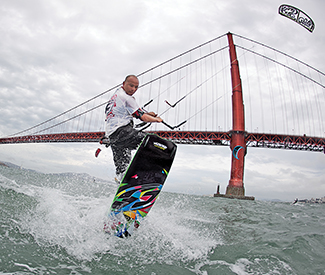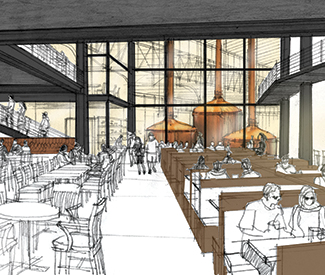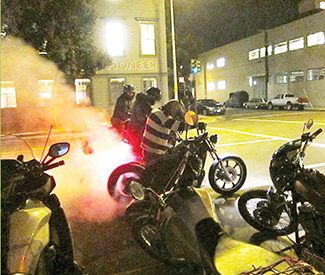arts@sfbg.com
CULTURE They’re out there in the water at Ocean Beach and Crissy Field, whipping by the toll plaza, sailing giant kites like crescent moons. Those freaky, flying water monkeys — soaring around the bay via kites strong enough to tow cars — are kitesurfers, also called kiteboarders.
Thanks to its ideal mix of geography and weather, the Bay Area is a phenomenal place for the increasingly popular sport. “It’s a world-class kiteboarding destination,” says Jeff Kafka, owner of Burlingame kiteboarding school Wind Over Water. “You might have to wear a wetsuit most of the time, but we have some of the best wind in the world.”
Kitesurfing is a combination of sailing, surfing, and power kiting, in which a large kite is used to pull a rider on any and all types of boards (surfboards, wakeboards) with and without foot straps. The kites range in size from as small as a kitchen table to as big as a bus; smaller kites are used in heavier winds, while bigger kites are used in lighter winds. The most common size is probably 12 meters (about as big as an average parking spot). Almost all kitesurfing kites have inflatable frames that keep them from sinking in the event of a crash.
Most kites have four lines that run to a control bar — letting the rider steer — which is hooked to a body harness that takes most of the pull. Quick release systems have evolved to help reduce the kite’s speed and even disconnect the rigging in the blink of an eye, drastically improving the safety of the sport. Contrast this to the sport’s early-1980s origins, when brothers Bruno and Dominique Legaignoux launched the first water kites off the Atlantic coast of France. In those days, a hunting knife strapped to one’s leg was considered a quick release system.
“A lot of people were getting hurt back then and we needed a safer way to continue the sport,” says Sandy Parker of the Kitopia School of Kiteboarding, in the Sacramento Delta. “That was part of the reason for forming the school.”
While the Bay Area is a hotbed for the sport, there are International Kiteboarding Organization-certified schools all over the world equipped with jet skis and radio helmets, ready to get newbies into the water as safely as possible. Traditionally, students are started with “trainer” kites — two-lined kites with little more power than a toy stunt kite.
“The trainer kite’s a good practice kite,” says Kafka. “You can send somebody off and they can mess around with very little instruction.”
But as safety systems and kites have advanced, some schools have begun putting large, powerful kites in people’s hands sooner.
“I don’t really recommend any trainer kite usage prior to coming out,” says John von Tesmar, with Treasure Island’s KiteTheBay. (His jet boat is named, appropriately, Windseeker.) “I hook the kite to the boat and, right then, you can get someone’s virgin hands on the bar.”
Either way, the next step is learning the safety systems, and how to independently steer a full-size kite. After that comes water maneuvers and then board start, when the student hopefully gets up and riding. This usually takes about four to six hours and is generally broken into two sessions. With lessons averaging around $100 per hour, a lot of people — especially experienced surfers and snowboarders — try to avoid taking lessons.
“Saying that you’re accomplished at boardsports but have zero kite experience is akin to saying you’re excellent at hitting a ball with a mallet but don’t know how to ride a horse, and now you want to play polo,” says Rebbecca Geffert of Boardsports School, which operates around the Bay Area. (Full disclosure: I am an IKO-certified kitesurfing instructor and teach at Boardsports.) “The kite is the horse. It’s all about kite control. Board skills are secondary.”
Adds Royce Vaughn of Emeryville’s KGB Kitesurfing, “At the end of the day, there are a lot of variables in kiteboarding. It’s not just as easy as learning how to fly a kite and jumpin’ on a board. There’s a lot of safety involved.”
Though lessons can be a bit steep, most shops give a discount on gear to students. Some will even throw in free lessons if you buy a complete set-up. And being involved with a school opens up a worldwide network of education, socializing, and employment. There’s more than one globe-trotting telecommuter out there who supplements his or her traveling expenses by teaching kitesurfing. Or perhaps you want to get into snowkiting or racing. The sport is full of possibilities.
“Once you get the basic mechanics, it’s just where you want to take it, what board you want to ride on, what types of tricks you want to do, or if you don’t want to do any tricks at all,” says Kafka. “Maybe you just want to have a nice afternoon ridin’ along in the bay.” *
International Kiteboarding Organization
Boardsports School
KiteTheBay
KGB Kiteboarding
Kitopia
Live 2 Kite



